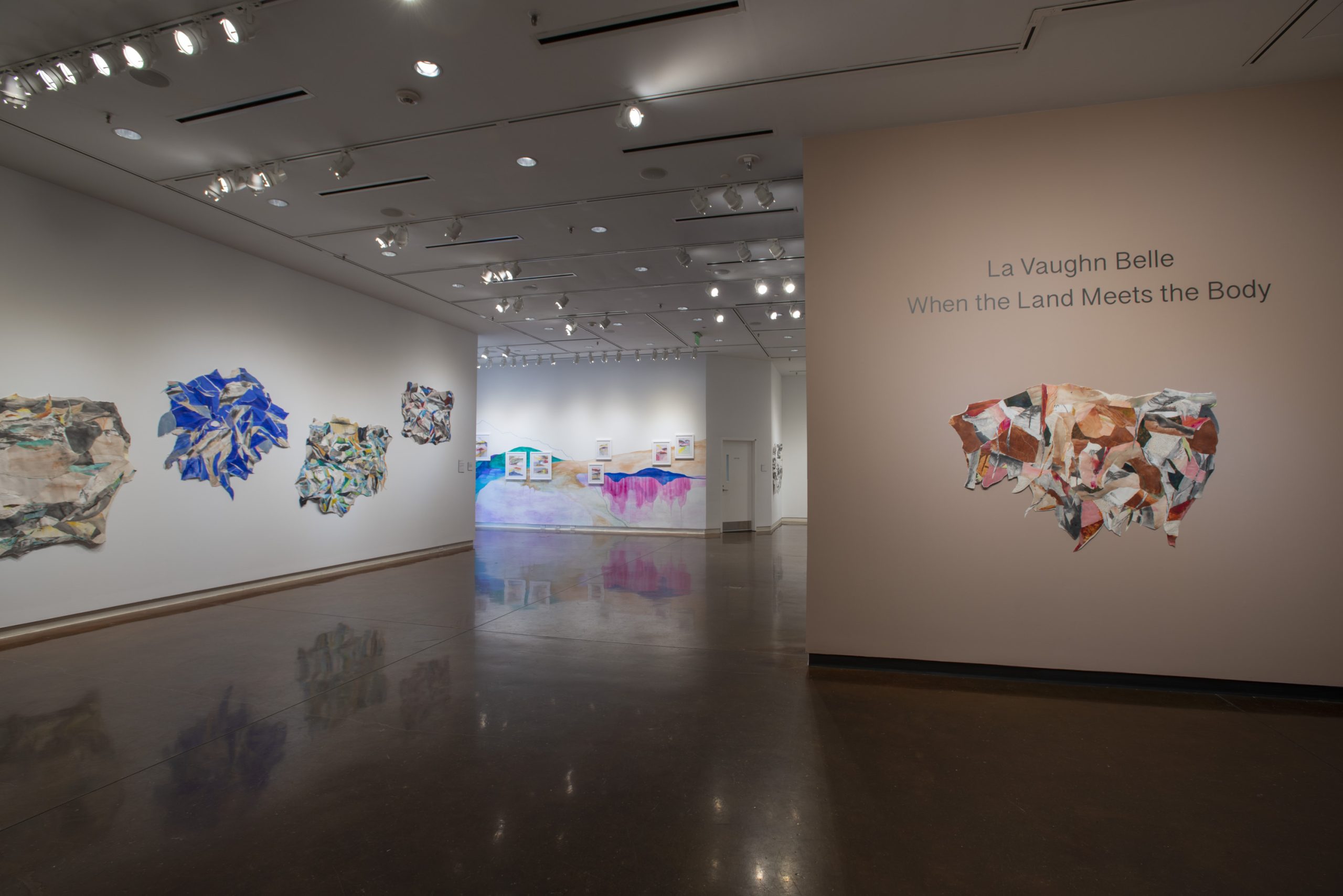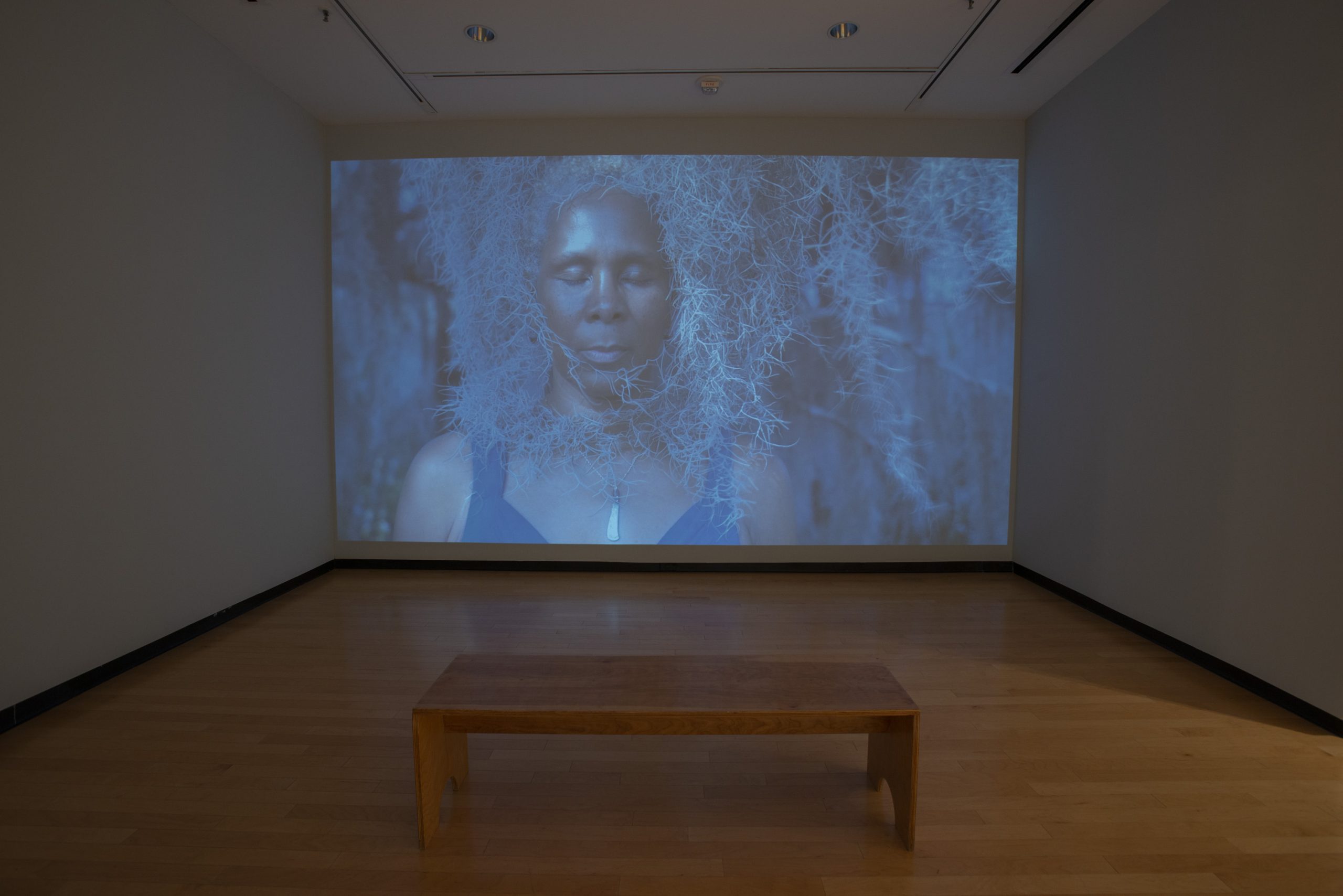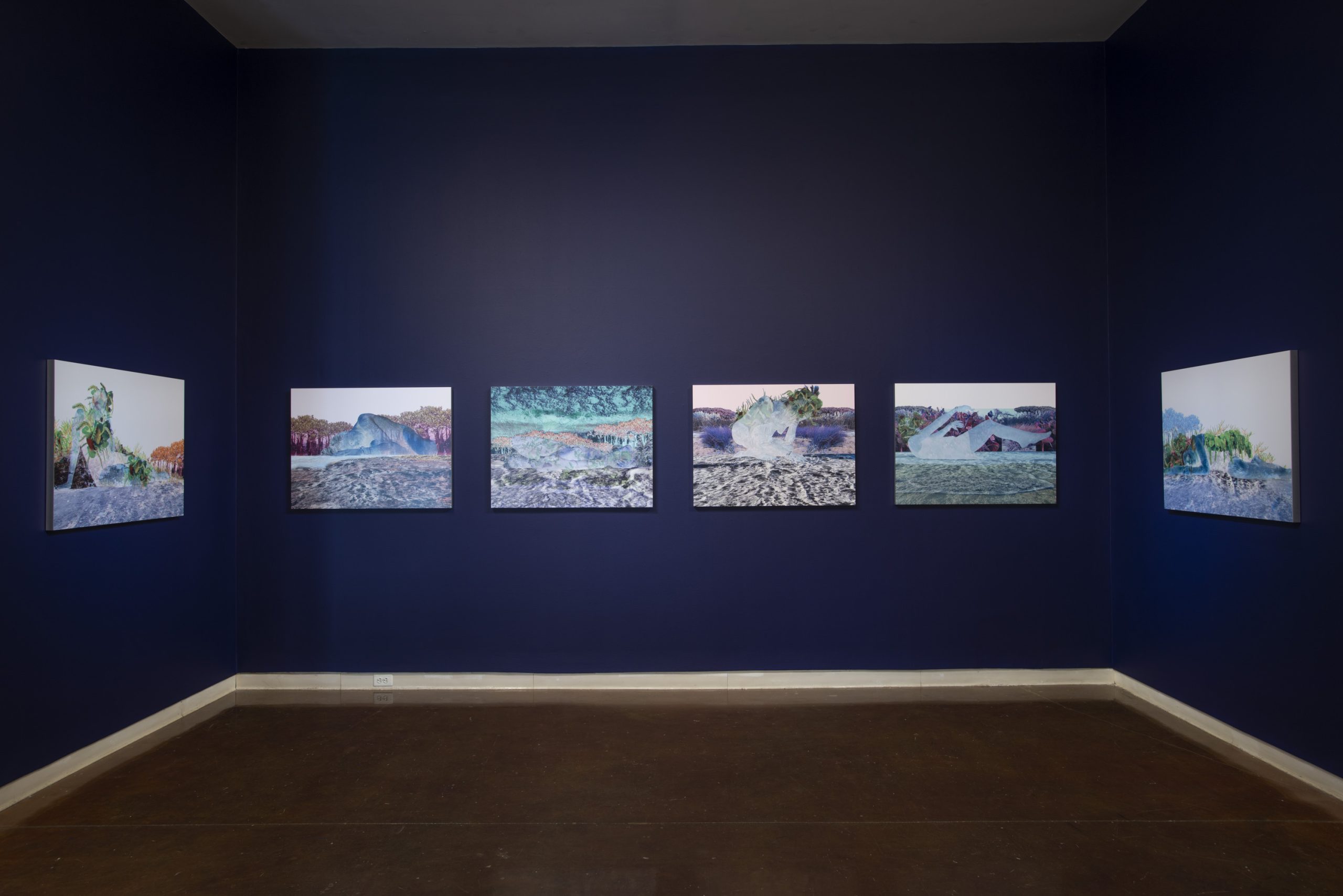


Students in Professor Mari N. Crabtree’s course, Race, Violence, and Memory in American History (AAST 340 | HIST 321), visited the Halsey Institute of Contemporary Art this fall to view La Vaughn Belle’s exhibit, When the Land Meets the Body. Their tour of the exhibit followed several weeks of reading texts from Michel-Rolph Trouillot’s Silencing the Past and Christina Sharpe’s In the Wake to Toni Morrison’s Beloved and Gwendolyn DuBois Shaw’s Seeing the Unspeakable. Through discussions of these and other texts, the class explored how conflicts over competing collective memories of slavery in the United States shape identity, public policy, the distribution of resources, and national character. During their visit, they selected one or two pieces from the exhibit to analyze, bringing together the arresting art they saw on the gallery walls and the key concepts of the course: collective memory; collective trauma; archival silences; the relationship between race, gender, and power; wake work; and landscapes haunted by history. These three essays provide a sample of their work in response to this powerful and necessary exhibit.

La Vaughn Belle’s Effluvia takes a spotlight in her exhibit When the Land Meets the Body, now on display at the Halsey Institute of Contemporary Art. What caught my eye was the deliberate switch from her usual Caribbean backdrop to filming in the Lowcountry for this particular piece. It got me wondering about what this choice meant. After giving it some thought, it hit me—Belle’s body acts as the bridge, connecting these two distinct places. Her presence in the video is more than just visual; it transforms into a symbol reflecting the far-reaching impact of slavery across the globe, tying together different parts of our world.
Belle’s physical presence narrates a dual story—bearing witness to the enduring scars of slavery while also embodying the unyielding resilience demonstrated by black communities in the face of adversity. She brilliantly utilizes her body as a tool to convey these concepts, through how she moves in the video, the words she speaks, and the carefully chosen plants, locations, and imagery shown in it. It’s like she’s crafting a sophisticated tapestry of symbolism that unravels the historical wounds and the strength of communities that have suffered through enslavement and its aftermath.
At the heart of this artwork lies the essence of pluff mud—a physical blending of life and death. It stands as a reminder of a muddy terrain historically used to revive cotton fields starved of nutrients, echoing the haunting history of slave labor imprinted on this land. Belle artfully weaves the tale of pluff mud with the scent of effluvia—the distinct odor emerging from the mud’s bacteria as they consume decaying matter. The effluvia, lending the artwork its name, symbolizes not just organic decomposition, but also holds within it the memory of enslaved individuals. It subtly suggests that, much like the mud carrying remnants of all the life it supports, it might have once carried the scent of enslaved souls lost to labor and brutality—a powerful symbol underscoring the deep and enduring legacy of slavery in the Western world.
The video unfolds through a sequence of carefully planned symbolic actions by Belle. Whether it’s digging into the earth, pondering what her body could do if it could perform actions yet to be verbalized, or presenting an inverted view of the shoreline where the water recedes instead of advancing—the artistic intent is clear. It’s a desire to reverse the painful history of the South and the rooted injustices of slavery, etched deeply into our collective memory.
An impactful moment in the video is when Belle adorns herself with Spanish moss, resembling a stoic figure emerging from a tree or hanging from an infested rope. This striking visual metaphor speaks volumes about the enduring impact of colonialism on the collective memory of the black community. It drives home the point that the scars of colonialism run deep, akin to the chiggers who live within the moss and burrow beneath the skin. Belle further immerses herself in the environment, gracefully floating in muddied water and gently touching the marsh grass, a force maintaining the stability of the coastline. These actions symbolize the intricate dance of nature with the historical forces that have shaped it.
To wrap up the video, Belle urges us to embrace being “ungovernable.” Standing amidst a thicket of dog fennel—a plant known for its resilience and aggressive growth wherever it is planted—she emphasizes the idea of resistance and the inherent strength in the human spirit. This symbolism is amplified by her choice to wear a cutlass necklace, symbolizing both revolt and a nod to the historical significance of the cutlass in the laborious task of harvesting—a powerful reminder of the legacy of struggle and resilience. Through Effluvia, Belle expertly blends history, contemporary commentary, and artistic expression, inviting us to confront our past, reflect on the present, and envision a more equitable and just future.

When I was looking around La Vaughn Belle’s installation, When the Land Meets the Body, I found myself immediately drawn to her series For Those of Us Who Live at the Shoreline. At first glance, it was the striking shades of blue and green and the inversion of natural colors that made these pieces so visually appealing. The way the art was situated within the exhibit—against a deep blue wall, almost resembling a sea—captured my attention long enough for me to fixate on the complexity of each individual piece in the series. Belle’s use of mixed media/collage to portray the intricate relationship between the human body and land was done in a way that undermines the destructive histories these landscapes encapsulate. Mixed media art has always fascinated me in ways a simple painting couldn’t; I enjoy the art of blending and the overlapping of ideas tied to different materials and mediums. Belle’s artwork does just that, and the maturity of each piece is eye-catching.
In two pieces, a feminine figure is posed upon a body of water in reference to the title of Belle’s series. To me, the poses speak to the way femininity is intertwined with one’s surrounding environment. In one piece, the figure seems to be kneeling with one leg propped up by her shoulder and the other supporting her weight. This particular pose invites a feeling of curiosity or reflection, as she is immersed in the landscape and appears to be stroking the shoreline. In another piece, the pose is less candid, and more unsheltered, encouraging a feeling of vulnerability. Both of these figures blend seamlessly with their surrounding environments, morphing with native plants of the ecosystem to construct “a kind of living archive as the roots systems hold in the erosion of memory and time,” as Belle puts it.[1] Belle’s artistic choices are cognizant of the complexity involved in representing murky and convoluted histories, and she utilizes these native plants that serve to filter and shelter an ecosystem—like our minds work to protect us from destructive pasts—to portray the act of remembering and the relief of selective forgetting.
In Belle’s artistic statement, she mentions that the title of her series, For Those of Us Who Live at the Shoreline, was borrowed from Audre Lorde’s poem “A Litany for Survival.” Extending beyond the simple act of Belle naming her series after the first line of Lorde’s poem, there is actually a profound connection between these two pieces as they are both engaging with collective memory. In a way, Belle’s artistic choices seem to be an extension of Lorde’s literary ones. In the poem, Lorde references “for those of us” several times in the first few stanzas—the “us” appears ambiguous at first glance, but it can be assumed, based on the context of the poem, that she is referring to a marginalized group of people who are “standing upon the constant edges of decision.”[2] This quote from Lorde’s poem is reflected directly in Belle’s artistic statement, where she refers to “those of us” whose “survival is based on the crucial decisions of what we remain rooted in and what we know must wash away.”[3] With this, Belle appears to be conveying the reality of living in the wake of slavery, with the land being representative of a burdensome past. The figures are made to blend with their surrounding environment to represent this past as feeling inescapable; however, they are posed in a way that represents Christina Sharpe’s idea of wake work, which is making the present more livable. Despite these landscapes being haunted by a dark history, these figures appear to be interacting with their environment in an attempt to decolonize these landscapes and undermine the pernicious memories they contain.
[1] La Vaughn Belle, For Those of Us Who Live at the Shoreline. Digital Collage, 2020-2023. Halsey Institute of Contemporary Art
[2] Audre Lorde, “A Litany for Survival,” in The Collected Poems of Audre Lorde (1978).
[3] Belle, For Those of Us Who Live at the Shoreline.

The exhibit room is sparse: its white walls are lined with revised archival pictures on hinges, like doors, allowing the viewer to see both the art and its negative. All the photos, images from Danish archives that were eventually returned (in Danish) to the West Indies long after their colonial withdrawal, have been artfully burned and ripped by the artist, La Vaughn Belle. The holes in the photographs are arranged in masses which overtake much of the landscape and obscure the white bodies in them. The Black bodies, however, are uplifted, even if they appear in the background like in the image of a Black man working with cattle, which I’ve chosen to analyze.
Belle’s act of burning her pieces revises the photographic history of Black people in the West Indies. All of the Black people photographed are present alongside Danish colonizers or with the crops or jobs they were forced to do. Through burning holes in the white people and the crops, the Black bodies become the subjects, not the silent props to, colonialism. Belle effectively gives them a history out of the grasp of colonial hands in each piece. Her choice to use fire is extremely evocative, considering that fire was a crucial tool in the rebellion of enslaved people in the West Indies.
My piece consists of a large open field occupied by a little over a half dozen cattle and one Black man looking after them. The figures are standing against a backdrop of mountain ranges. The cattle are closer to the foreground than the man. The holes, engulfing but not concealing him, swallow up all of the livestock and tendrils creep to the edges of the frames and peek over the mountains. In the original image, the cattle are given priority, and even importance, over the Black man because of their proximity to the foreground. One has to get very close to the work to get a good look at him. After Belle’s revision, the Black man is the subject: independent, contemplative, powerful, and lonely. He is no longer a man carrying out a job forced upon him, but a lone figure in a large expanse. He is no longer swallowed by his surroundings but made indigestible.
Belle’s choice of burning in Swarm is representative of a larger theme found in her other work: the undeniable presence of a body. The viewer is reminded of the initial action of burning holes in the present. In other words, the holes are existing only because of the fire that once touched the image. This is the same for the land that we all live in and on. We see the aftereffects of slavery as an institution in our day to day. In her video, Effluvia, she walks through the marshes of Charleston which exist only because of the manipulation of the land by enslaved labor in hopes of a yield of rice. Belle asserts that our physical environments are merely echoes of former actions.
Christina Sharpe writes about a concept called “wake work” in her book, In the Wake. She writes, “[If] we join the wake with work in order that we might make the wake and wake work our analytic, we might continue to imagine new ways to live in the wake of slavery, in slavery’s afterlives, to survive (and more) the afterlife of property. In short, I mean wake work to be a mode of inhabiting and rupturing this episteme with our known lived and un/imaginable lives.”[1] Belle’s Swarm is a form of wake work. It’s a visual disruption of the wake of slavery to create and inhabit a space where slavery is both reckoned with and grieved.
[1] Christina Sharpe, “The Wake,” in In the Wake: On Blackness and Being (Durham, NC: Duke University Press, 2016), 18.